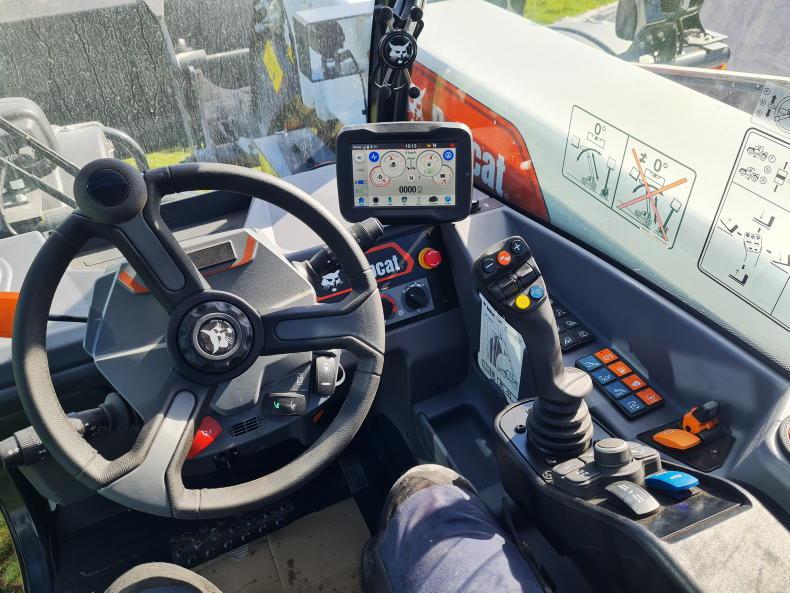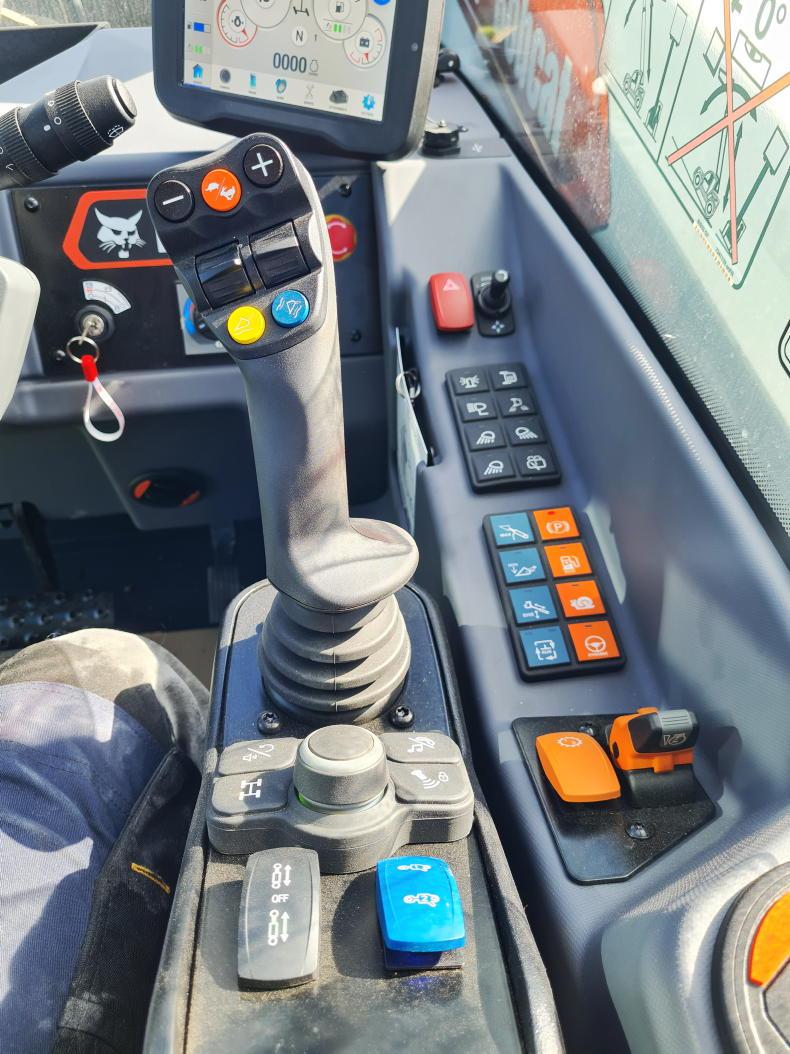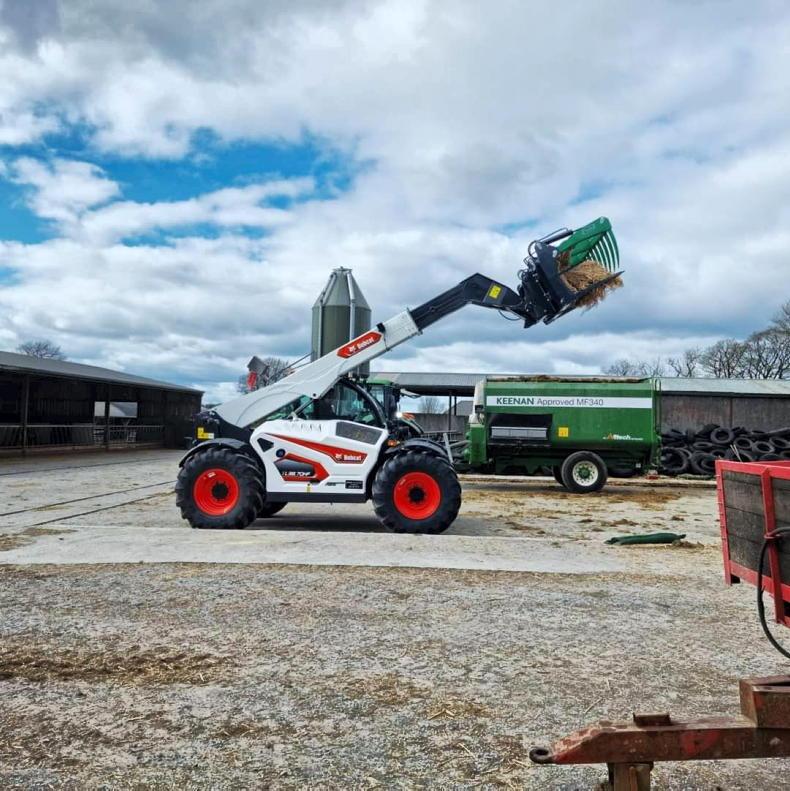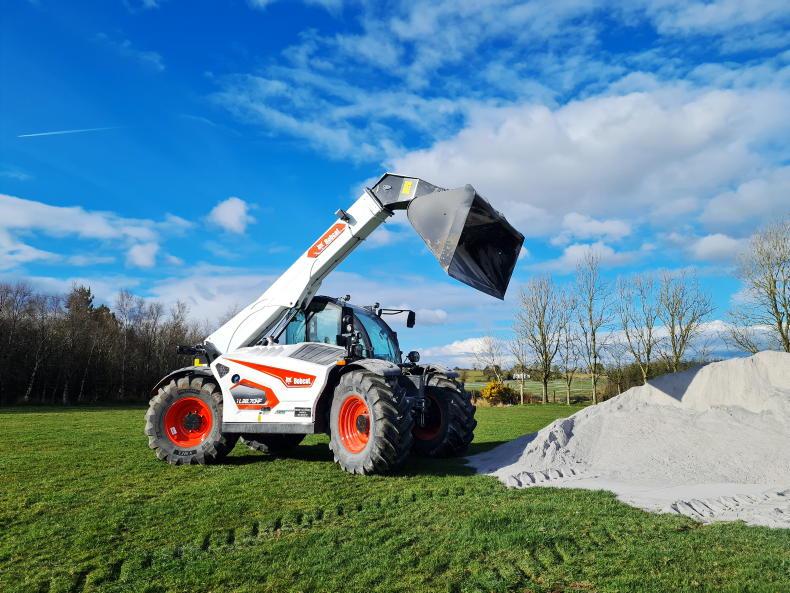A relatively new player to the agricultural telehandler market, Bobcat has quickly gained ground and established itself as a real competitor within the industry.
Manufacturing agricultural spec telehandlers for just over a decade, the firm brings a lot of experience from its skid steer and construction teleporters and recently released its updated Stage V R-Series model lineup.
Although looking somewhat similar from a distance, the manufacturer has made many subtle changes to the design, and particularly has given the cab a complete overhaul.
The latest TL38.70HF model has an operating weight of 7,330kg, 135hp on tap, a maximum lift height of 7m and a maximum lifting weight of 3.8t, meaning it’s a very capable machine for most Irish farms. We recently spent some time with the telehandler and put it through its paces.
Engine
Previously using Deutz and Perkins engines in its agricultural telehandler range, the new TL38.70HF sports Bobcat’s own turbocharged 3.41l engine.

This four-pot powertrain is a Stage V compliant upgrade of its predecessor, and generates 135hp (101kW), which is a 5hp increase on the outgoing model. The engine uses a Diesel Oxydation Catalyst (DOC) and SCR-Catalyst on Diesel Particulate Filters (SDPF) to meet emissions regulations. This latest engine also encompasses an additional 12% torque, which was noticeable when the engine came under load, with power not being a limiting factor in the tasks we used it to tackle.

Despite having clocked just over 22 hours of work since assembly, the four-cylinder engine proved efficient on fuel, while we also deemed AdBlue consumption to be on the lighter side. One point we did note is that at 138l, the fuel tank is a bit on the small side for those with very long working days to get through.
Similar to its predecessor, once the single-piece bonnet is folded up, access to the air filters, oil filters, oil reservoirs and the radiator is as good as you could ask for. The self-cleaning cooling system, thanks to the automatic reversible fan with changeable intervals (every five minutes and 15 minutes), means there’s one less maintenance issue to worry about.
Transmission
The TL38.70HF features a hydrostatic transmission which is complemented by a two-speed mechanical gearbox, known as a hydro-mechanical box. The operator changes between the ranges by pressing a rocker switch to the right of the main joystick. When shifting between the ranges, the machine has to be at a complete standstill.
Designed to offer higher torque when handling heavy materials, both first and second gears have a high and a low range (rabbit and tortoise). This is down to the two-speed hydrostatic motor (sourced from Danfoss) that can be changed on the move, through a button on the main joystick.

The telescopic handler is fitted with the reputable Italian-manufactured Dana-Spicer axles. These heavy-duty oil immersed axles have a central differential gear and planetary gears in the hubs.
The machine features up to four steering modes, including two-wheel steering, four-wheel steering, crab-steering and semi-crab steering, the latter of which is optional. These modes can be easily changed with the switch of a button, while a semi-automatic wheel alignment feature helps the operator.
Cab
The most notable change from the Stage IV to the Stage V model is the revamped cab. From the outset upon entry, you get a proper premium feel from this latest offering from Bobcat. The manufacturer clearly has moved to a higher-quality plastic trim finish, while opting for automotive-style controls. Much of the control setup has been rejigged and repositioned.

The controls are now intuitively laid out with new colour coding and individual elements backlit to allow the operator find features quicker.
The company has also equipped the R-Series with a new, reworked control joystick which is mounted on the seat armrest. As per the outgoing joystick, the electro-proportional unit continues to control forward/neutral/reverse, all boom movements, the auxiliary controls and flow rate and the boom suspension.

The new joystick includes the same, with the big improvement being moving the F/N/R shuttle to the rear. This was an issue we had previously flagged with the Stage IV model.
With the forward/reverse shuttle previously on the top of the joystick, in between the pushing out/retracting of the boom and the third service, it almost limited the possibility of carrying out more than one function at a time, as your thumb has to perform two tasks. The manufacturer also added an optional bucket shake feature.

Other tweaks to the controls include a new hand throttle. Although we didn’t have specific use for this, it would be ideal for using a hydraulically powered implement that would require a constant flow of oil such as a road sweeper.

The cab in the TL38.70HF continues to boast the same five-pillar design, but visibility to the right over the bonnet has been much improved. This is thanks to the new hood design which is lower and descends more aggressively towards the front and rear wheels, with Bobcat claiming a 15% increase in side visibility over the outgoing model.
Bobcat has transitioned from an old-fashioned built-in control terminal to a modern interactive 7in touchscreen which features a built-in radio and a phone page. Once put into reverse, the feed from the rear camera is displayed on the terminal.
Lighting wasn’t an issue, with the eight LED work lights providing ample illumination at night. The unit was even fitted with electric mirrors which had a de-icing function. Something small, but that’s needed by everyone and is rarely included on new machines is a quality phone holder. A new quick-cleaning function allows all wipers and washers to be activated by pushing one button.
Another feature we liked was the automatic engaging and disengaging of the handbrake, comparable to modern cars. The handbrake is automatically engaged when the machine is in neutral for three seconds.
Hydraulics
Similar to the outgoing model, the HF (high flow) feature on the TL38.70HF means the load-sensing pump supplies a sizeable 190l/min at 255 bar (150l/min for the auxiliary line).
The hydraulics proved to be very smooth and fast, even when using several functions simultaneously.

One really nice function is the auxiliary flow management which allows the operator to regulate the oil flow (0-100%) to the hydraulic attachments through the joystick in the cab, by simply pressing the plus or minus buttons.
Bobcat’s auto boom suspension uses a two-stage accumulator system, which allows it to adapt to different load sizes. The feature is managed according to the speed. Once travelling over 5km/h, the feature is engaged but while travelling below 5km/h the suspension feature is disengaged. The boom suspension can be easily switched on or off using a central button on the main joystick. If the boom suspension was turned off, you would quickly spot it, with the feature greatly improving ride comfort.
The boom cushion is a gift, and allows for a smooth motion when the boom is close to minimum and maximum angles, or close to full retraction, with a reduced sudden halting of steel on steel at high pressure.
A bit about Bobcat
Bobcat’s roots trace back to 1958, when the Melroe Manufacturing Company introduced a compact front-end loader that evolved into the M400, the world’s first true skid-steer loader. This company soon adopted what became the Bobcat brand.
To this day, Bobcat is best known for its skid-steer loaders. The manufacturer first entered the agricultural telescopic loader market in 2011 with two models. In the following years, it increased its agricultural portfolio to seven telescopic loaders with three levels of specification.
Adare Farm Machinery in Co Limerick has been the Bobcat importer in Ireland since 2015. It has sold Bobcat telehandlers since then, though it was mainly construction machines until a new range of agri telehandlers was introduced in 2017/18.
Bobcat telehandlers have also been sold in Massey Ferguson livery for decades. Bobcat previously sold its own branded handlers solely for into the construction sector, before selling directly into the agricultural sector. The loaders are still available in Massey colours.
With this latest product, Bobcat has listened to the many operators of its previous generation machines and made the changes where its predecessor was being let down. We felt the cab was previously the most outdated aspect.
The quality of trim used, the control layout and the control functionality has certainly been addressed and the new cab in the latest version is up there with the best on offer in the telehandler segment. The manufacturer also improved visibility, especially from the driver seat to the blind spot across the bonnet, which is vital from a safety aspect.
With the tasks we put it up against such as cleaning out sheds, loading lime and foddering, the TL38.70HF proved to be a very capable, yet nimble machine in restricted areas. The handler is manufactured using reputable components from the likes of Danfoss, Dana Spicer and Bosch.
We could only praise the build quality, while the additional 5hp from the Stage V motor was warmly welcomed.
Similar to our last review, we can’t overlook the impressive warranty package on offer. In a time when the fixed costs of any operation are getting more and more difficult to pin down, a standard three-year or 3,000 hour warranty with the option to increase to five year or 5,000 hours is definitely very attractive.
Overall, we feel Bobcat is packing a good punch with its latest range, offering a well put together and well-thought-out product with many smart and intuitive features.
With its latest series, the manufacturer has brought its product up another notch.
With such a finish and spec, one couldn’t but consider Bobcat when in the market to upgrade or purchase.
Engine: 3.4l Bobcat four-cylinder Stage V.
Horsepower: 135hp (101kW).
Transmission: Hydrostatic motor with two-speed gearbox.
Max lifting capacity: 3,800kg.
Max lift height: 7m.
Forward speed: 40km/h.
Hydraulic output: 190l/min (150 l/min for the auxiliary line).
Operating Weight: 7,330kg.
Diesel tank: 138 litres.
AdBlue tank: 28.8 litres.
Tyres: Michelin 500/70 R24.
Starting price as tested: €95,000 plus VAT (4 Star Agri).






 This is a subscriber-only article
This is a subscriber-only article









SHARING OPTIONS: